A History of Football Kit Design in England and Scotland
(2) Gentlemen and Players 1880-1900
The teams of gentlemen players that had dominated the game were now facing a challenge from the new breed of clubs that were springing up in Lancashire and the Midlands. These were backed by self-made businessmen who drew their players from the textile mills, engineering works, coal mines and factories that were booming as the Industrial Revolution gathered pace. Furthermore, labour reforms meant that most working people now 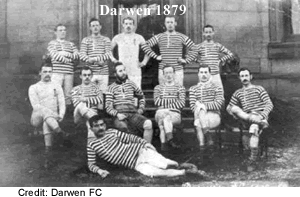 had Saturday afternoons off and could be readily persuaded to come and watch their local football team. By enclosing their grounds and charging admission, these clubs generated revenue that could be spent on improving their facilities. (The gentlemen-player clubs were funded by members' subscriptions and spectators were regarded as a nuisance.)
had Saturday afternoons off and could be readily persuaded to come and watch their local football team. By enclosing their grounds and charging admission, these clubs generated revenue that could be spent on improving their facilities. (The gentlemen-player clubs were funded by members' subscriptions and spectators were regarded as a nuisance.)
There were strong suspicions that several of these clubs were offering financial inducements to attract the best players, many of whom came from Scotland and were familiar with the "combination game" that would prove superior to the "kick and rush" style that prevailed in England. In 1878 Darwen recruited the first of the "Scotch Professors," Fergie Suter and James Love with offers of employment. Suter, a stonemason, was unable to ply his trade in Lancashire as the stone was too hard to work but he nevertheless was able to support himself. The club secretary denied that either player was paid but in 1902 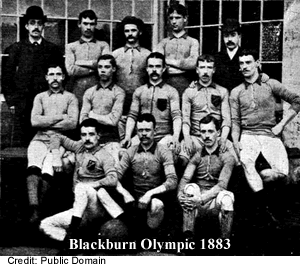 Suter told a reporter,
Suter told a reporter,
"We had no settled wage, but it was understood that we interviewed the treasurer as occasion arose. Possibly we should go three weeks without anything, and then ask for £10 (£1,500 in 2023 prices). We never had any difficulty." (Lancashire Daily Post 13 December 1902.)
In March 1883, Blackburn Olympic, became the first team made up of working men to win the FA Cup, beating Old Etonians. This was the last time that any of the former public school teams would appear in the final.
In 1879 Edward Robinson Buck opened a factory to manufacture shorts for The Army which was engaged in fighting the Boer War. In 1884 the company provided the playing kit for Nottingham Forest. After moving into larger premises in Manchester, ER Buck & Sons branched 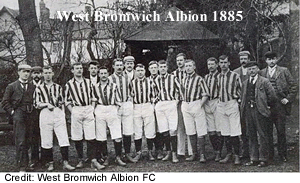 out, supplying uniforms to the Scout Movement and The Army as well as football kit. Under the brand name Bukta the company would become the first and largest supplier of sportswear in the UK.
out, supplying uniforms to the Scout Movement and The Army as well as football kit. Under the brand name Bukta the company would become the first and largest supplier of sportswear in the UK.
Around 1885 shirts with vertical stripes begain to appear. These were at the time quite difficult to produce as looms could only produce jerseys with stripes that went from side to 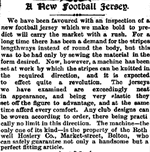 side. Vertical stripes could only be made by cutting cloth and sewing it up in the desired form, which added to the expense. West Bromwich Albion were among the early adopters followed by their near neighbrours Aston Villa a few years later.
side. Vertical stripes could only be made by cutting cloth and sewing it up in the desired form, which added to the expense. West Bromwich Albion were among the early adopters followed by their near neighbrours Aston Villa a few years later.
In 1887 the Rothwell Hosiery Company of Bolton introduced a novel machine that 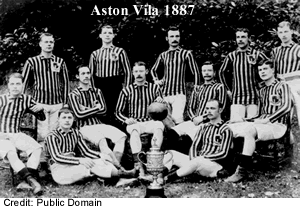 allowed stripes to be knitted in any direction. The style proved extermely popular and the directors should have made their fortunes but they overeached themselves and in November 1894 the company was wound up. A year later two of the directors, William Rothwell and William Entwhistle were found guilty of fraud, having published misleading accounts in an attempt to raise new investment. They were sentenced to 18 and 9 months hard labour respectively.
allowed stripes to be knitted in any direction. The style proved extermely popular and the directors should have made their fortunes but they overeached themselves and in November 1894 the company was wound up. A year later two of the directors, William Rothwell and William Entwhistle were found guilty of fraud, having published misleading accounts in an attempt to raise new investment. They were sentenced to 18 and 9 months hard labour respectively.
It has long been widely believed that vertical stripes make people look taller while horizontal stripes emphasis a person's bulk and in 2012, Val Watham, an amateur scientist, demonstrated that this effect really exists. This is likely to be the reason that vertical stripes became so 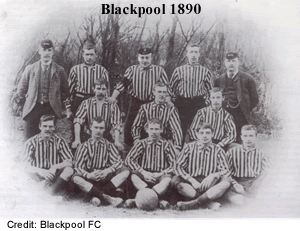 popular in association football, a sport that requires the ability to leap off the ground to head (or catch in the case of goalkeepers) the ball. Rugby, on the other hand, is a game that emphasises physical strength and is associated with hooped jerseys.
popular in association football, a sport that requires the ability to leap off the ground to head (or catch in the case of goalkeepers) the ball. Rugby, on the other hand, is a game that emphasises physical strength and is associated with hooped jerseys.
Curiously, Scotland seems to be the exception that proves the rule. Hooped tops became popular there in the early 20th century and remain so today.
As technology advanced striped shirts became available in a variety of widths. These ranged from one-inch stripes right up to the very broad stripe favoured by Civil Service FC
Over time the exotic colour combinations of the previous two decades began to disappear. In the days of "kick and rush," one player on the attacking side would attempt to dribble the ball towards their opponent's 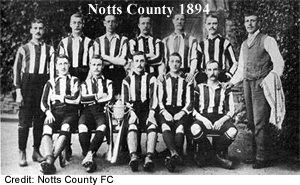 goal supported
by a mob of players, attempting to force their way through the defenders by sheer weight of numbers. Play resembled a rolling maul in rugby and team colours were not that important as all the attacking players would be together and moving towards the opponent's goal while the defenders tried to stop them.
goal supported
by a mob of players, attempting to force their way through the defenders by sheer weight of numbers. Play resembled a rolling maul in rugby and team colours were not that important as all the attacking players would be together and moving towards the opponent's goal while the defenders tried to stop them.
With the introduction of the "combination game" passing the ball to team-mates became key. It was now essential that the player in possession could distinguish his colleagues from his opponents. While multi-coloured shirts might look attractive as the players trotted onto the pitch, they could be difficult to pick out on a gloomy winter afternoon, especially when covered with mud.
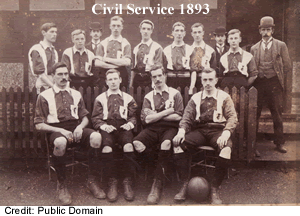 Economic factors were probably more significant. A survey
of Scottish clubs in the 1870s and early 1880s reveals that most team wore plain jerseys (navy, red, maroon, green or rarely white) or narrow hoops
in a combination of two colours. Players had to buy their
own kit in those days: the working class lads that took up the sport in Scotland would not
be inclined to join clubs that required expensive colour combinations associated
with public schools or universities that they had no connection with.
Economic factors were probably more significant. A survey
of Scottish clubs in the 1870s and early 1880s reveals that most team wore plain jerseys (navy, red, maroon, green or rarely white) or narrow hoops
in a combination of two colours. Players had to buy their
own kit in those days: the working class lads that took up the sport in Scotland would not
be inclined to join clubs that required expensive colour combinations associated
with public schools or universities that they had no connection with.
One or two unique strips deserve a special mention. Journalist Jack Urry recalled watching Aston Villa play Bolton Wanderers in 1884, "At the time (Bolton) played in white jerseys with blobs of scarlet about the size of threepenny-bits dotted all over them - the most hideous dress ever known." (Aston Villa News & Record 1920).
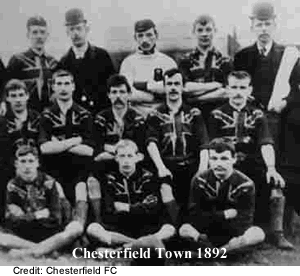 Even more spectacular were the shirts worn by Chesterfield Town in 1892-93. These are believed to have been found in the loft of the Spital Hotel in Chesterfield and were donated to the club by the landlord. It seems they were originally made for Spital United, an amateur team that had been wound up in 1885.
Even more spectacular were the shirts worn by Chesterfield Town in 1892-93. These are believed to have been found in the loft of the Spital Hotel in Chesterfield and were donated to the club by the landlord. It seems they were originally made for Spital United, an amateur team that had been wound up in 1885.
The divide between the clubs from the north and midlands, where professionalism was becoming an open secret and the southern teams which held to the amateur principles espoused by the FA came to a head in 1884 after Preston North End beat Upton Park in the FA Cup. The Londoners protested, accusing the Lancashire side of fielding professionals. Preston's directors did not deny the charge; on the contrary they argued that there was nothing wrong with paying players and the practice was widespread. The FA  disqualfied the club and banned them for the following season. Burnley and Great Lever withdrew in solidarity and soon more than 30 clubs were threatening to withdraw from the FA and set up a rival British Football Association. The FA eventually caved in and in July 1885 professionalism was formally recognised in England.
disqualfied the club and banned them for the following season. Burnley and Great Lever withdrew in solidarity and soon more than 30 clubs were threatening to withdraw from the FA and set up a rival British Football Association. The FA eventually caved in and in July 1885 professionalism was formally recognised in England.
There was considerable hostility towards professional players from the amateur establishment. When Jimmy Forrest (Blackburn Rovers) became the first acknowledged professional to be picked for England in 1885, (Over the objections of the Scottish FA) he had to wear a differently coloured shirt to those of his colleagues and forgo his £1 (equivalent to £154 in 2023) wages for the week of the match.
Arranging a sufficient number of fixtures against strong opponents that would attract paying spectators had by now become a major headache and it was not unusual for clubs to cancel matches 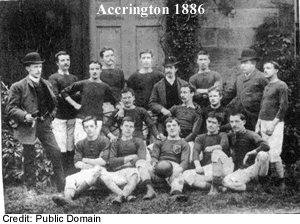 at short notice. In 1881 Darwen postponed their Lancashire Cup fixture with Blackburn Rovers to fulfill an FA Cup match. In retaliation, Blackburn cancelled the rearranged fixture at the last moment in order to play Nottingham Forest leaving Darwen (who had canceled a lucrative friendy against Partick Thistle in order to play Rovers) severely out of pocket. To address this issue, William McGregor wrote to his own Aston Villa directors and those of five leading profesional clubs to propose the formation of a competition that would guarantee members regular fixtures. On 23 March 1888 the Football League was formed with 12 members. This was followed by the short-lived Combination (which collapsed due to poor organisation) and the Football Alliance (1889-1892).
at short notice. In 1881 Darwen postponed their Lancashire Cup fixture with Blackburn Rovers to fulfill an FA Cup match. In retaliation, Blackburn cancelled the rearranged fixture at the last moment in order to play Nottingham Forest leaving Darwen (who had canceled a lucrative friendy against Partick Thistle in order to play Rovers) severely out of pocket. To address this issue, William McGregor wrote to his own Aston Villa directors and those of five leading profesional clubs to propose the formation of a competition that would guarantee members regular fixtures. On 23 March 1888 the Football League was formed with 12 members. This was followed by the short-lived Combination (which collapsed due to poor organisation) and the Football Alliance (1889-1892).
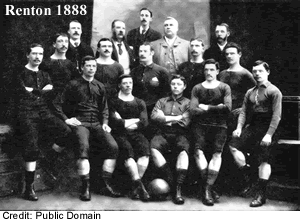 The Scottish Football League was formed in 1890 but professionalism was not permitted in Scotland until 1893, so the drain of talent to the south accelerated.
The Scottish Football League was formed in 1890 but professionalism was not permitted in Scotland until 1893, so the drain of talent to the south accelerated.
Taken together, the rise of the professional clubs and the formation of league competitions drove further change in the design of football kit. The game was now a spectator sport in which the ability of supporters to pick out their own team from a distance became evident, giving added impetus to the development of simple kits in contrasting, strong colours. Furthermore, the expense of buying playing kits now fell on the club rather than the players. Treasurers with an eye for the accounts naturally preferred to spend as little as possible reinforcing the trend towards simpler kits in basic colours that were cheaper.
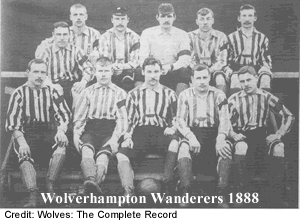 In September 1890, Wolverhampton Wanderers travelled to newly elected Sunderland and to the embarrassment of everyone concerned, both teams took to the pitch in identical
In September 1890, Wolverhampton Wanderers travelled to newly elected Sunderland and to the embarrassment of everyone concerned, both teams took to the pitch in identical 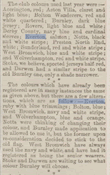 red and white striped shirts. The kick-off was delayed while the home side scrabbled around to find a set of white shirts.
red and white striped shirts. The kick-off was delayed while the home side scrabbled around to find a set of white shirts.
To avoid a repetition, clubs were instructed at the AGM of 1891 to register their colours for the following season, with a stipulation that
no two teams could register the same colours. These were then published in the first Football League Handbook which was distributed to members. This cutting (Burnley Express 11 July 1891 - click for a larger image) indicates 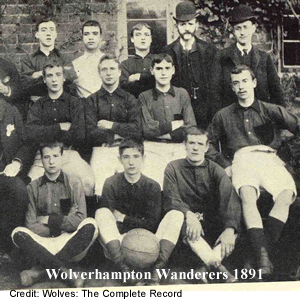 that Stoke and Darwen were waiting to see what colours Burnley would register while Wolves adopted orange and blue. Although it seems they took delivery of their new colours, they were dropped in favour of old gold and black diagonal halved jerseys when the new season started. The shirts shown here are believed to be the unused orange and blue set.
that Stoke and Darwen were waiting to see what colours Burnley would register while Wolves adopted orange and blue. Although it seems they took delivery of their new colours, they were dropped in favour of old gold and black diagonal halved jerseys when the new season started. The shirts shown here are believed to be the unused orange and blue set.
This rule was relaxed when the Football Alliance was incorporated as the new Second Division in 1892 and it became a requirement that each club should have a set of white tops to be worn when colours clashed (presumably teams that normally wore white had coloured alternatives.) The senior team (ie the one that had been members of the Football League the longest) was entitled to play in their regular strip. Since all member clubs now had a record of their opponents colours, clashes should no longer occur.
In 1892 Aston Villa wore claret woolen jerseys with contrasting light blue sleeves and a distinctive neck band for the first time. It is widely believed that Ollie Whateley, who was Villa's third England international and a 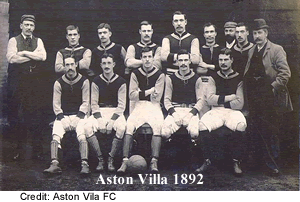 graphic designer by trade, created this design but some authorities think he was actually responsible for coming up with the club's claret and light blue colours. Different designs were worn in the following three seasons before the classic contrasting sleeves became a permanent fixture. Remaining substantially unchanged for over 60 years, this combination was the first truly iconic football jersey and was widely copied.
graphic designer by trade, created this design but some authorities think he was actually responsible for coming up with the club's claret and light blue colours. Different designs were worn in the following three seasons before the classic contrasting sleeves became a permanent fixture. Remaining substantially unchanged for over 60 years, this combination was the first truly iconic football jersey and was widely copied.
Black knickerbockers became available in the 1880s for the first time alongside the familiar white and dark blue versions. There are very few recorded examples of other colours making an appearance. In 1888 Notts County played Blackburn Rovers wearing "white jerseys and chocolate pants," (Blackburn Standard & Weekly Express 17 December 1888) and the same outfit appeared against Aston Villa. Derby County were recorded wearing light blue shirts and brown knickers in 1889. Between 1879 and 1888 Walsall Swifts wore maroon jerseys although detailed research has 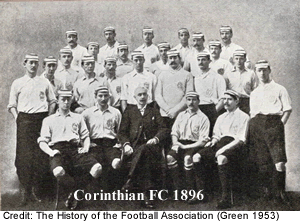 shown these were not available from local outfitters. In The Birth of the Saddlers (Mike Bradbury 2014), the author argues that the players, most of whom worked in the local tanning industry and had easy access to maroon dye, used this on their jerseys and knickers to fashion a distinctive strip. The Football League handbook for 1892-93 records that Burslem Port Vale wore grey knickers as did Manchester City in 1895-96.
shown these were not available from local outfitters. In The Birth of the Saddlers (Mike Bradbury 2014), the author argues that the players, most of whom worked in the local tanning industry and had easy access to maroon dye, used this on their jerseys and knickers to fashion a distinctive strip. The Football League handbook for 1892-93 records that Burslem Port Vale wore grey knickers as did Manchester City in 1895-96.
The professional teams largely eschewed the wearing of crests, probably because they were an unnecessary expense. The practice was, however, continued by several amateur sides, particularly in the south of England. Corinthian FC had been formed in 1882 to promote "sportsmanship, fair play and playing for the love of the game. Conceived as a means to bring together the best amateur players in England, they did not play on Saturdays (when members would be playing for other clubs) and declined to participate in competitive leagues or cups. They believed that a gentleman would never commit a deliberate foul and if a penalty  was awarded against them, the goalkeeper would stand aside to let their opponents score. They were the greatest amateur side in England and provided the bulk of England internationals for the rest of the century. "With an intelligent nonchalence and in their tailored shirts and well-cut shorts they brought a quality and culture to the game." (Corinthians and Cricketers, Edward Grayson 1955.)
was awarded against them, the goalkeeper would stand aside to let their opponents score. They were the greatest amateur side in England and provided the bulk of England internationals for the rest of the century. "With an intelligent nonchalence and in their tailored shirts and well-cut shorts they brought a quality and culture to the game." (Corinthians and Cricketers, Edward Grayson 1955.)
Vampires FC from Crouch End had more humble aspirations but they also stuck firmly to amateur principles, declining an offer to join the proposed Southern League as it would involve turning professional. They played regular friendlies with top flight clubs like Tottenham Hotspur, Millwall Athletic and Queens Park Rangers throughout the 1890s.
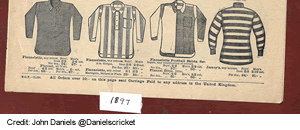 This fragment from a catalogue printed in 1897 shows that football shirts were available in men's sizes made from flanelette (brushed cotton) for 27/- to 30/- (£225-£250) per dozen while flannel (all wool) versions were about twice the price. The jerseys come in at 24/- a dozen (£330) so were presumably made from machine knitted cotton.
This fragment from a catalogue printed in 1897 shows that football shirts were available in men's sizes made from flanelette (brushed cotton) for 27/- to 30/- (£225-£250) per dozen while flannel (all wool) versions were about twice the price. The jerseys come in at 24/- a dozen (£330) so were presumably made from machine knitted cotton.
© Dave Moor (2023)